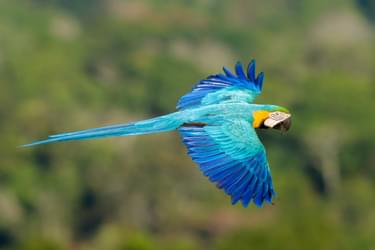


A new species of plant has been discovered in the Amazon. Specimens have been found in the Cristalino State Park and the Cristalino RPPN, in the state of Mato Grosso. The information was announced in May, in the Kew Bulletin, a magazine published by the Royal Botanic Gardens, in Kew, London. Ichthyothere sasakiae was found by a team of researchers from the Kew Royal Botanic Gardens, led by William Milliken, and its Brazilian partners, the Cristalino Foundation, within the municipalities of Novo Mundo and Alta Floresta, Mato Grosso. Of the 1,366 floral species already cataloged in the area of the Cristalino State Park, this is the fourth new discovery – the others being Sciadocephala gracieliae, Guarea zepivae and Passiflora cristalina – while a fifth is currently being described.
The new species was called sasakiae in honor of the Brazilian biologist Denise Sasaki, the first person to sample the material used for the description of the species and, at the time, coordinator of the project. "I was very happy to see my name linked to the Cristalino flora. I feel it is a form of recognition for our work," Denise told us. The head of research, Nicholas Hind explained his decision regarding the name. "The Ichthyothere genus is not very large, with approximately 28 species in South and Central America and about 19 of them catalogued in Brazil. There is plenty of variety in how these species have been named: some given names of people, others based on features of the plant, plus a few place names. We decided to honor our fellow team member."
The sasakiae was discovered in the Cristalino State Park, under the Cristalino Flora project, which is compiling a list of local plant species. With 184,000 hectares of preserved Amazon forest, this conservation area was established in 2000/01, with the intention of protecting the local fauna, flora, water sources, rivers, waterfalls, forests and landscapes, as well as enabling ecotourism, environmental education and scientific research. Consequently, it was essential to conduct a floral inventory and map the biodiversity of the park, for the development of a suitable management plan.
The Cristalino Flora project came about as a result of this need and is a collaborative program that includes the Cristalino Ecological Foundation (FEC), the State University of Mato Grosso (UNEMAT), the University of São Paulo (USP), the Mato Grosso State Department of the Environment (SEMA-MT), the National Council for Scientific and Technological Development (CNPq) and the Royal Botanic Gardens, Kew. The project is sponsored by the Kew-Rio Tinto association. This species also occurs in the Cristalino RPPN (Private Natural Heritage Reserve), the first reserve to be established in the north of Mato Grosso state, back in 1997.
The Ichthyothere genus belongs to a tribe of the Compositae family, which contains the genus Helianthus – the sunflower – and it was first described in 1830, by Martius, in a pharmacological journal. The researcher had gathered the plant in São João do Príncipe, on the River Yupará, in the Rio Negro province, because of the use of a fish poison obtained from the species that he described as Ichthyothere cunabi. The Ichthyothere sasakiae is a sturdy shrub that has many branches and a simple woody main stem and is found growing among rocks in an area that contains a very restricted type of vegetation called Rupestrian Vegetation. The flowers are white or greenish white and are very small.
Nicholas Hind explained another detail that makes this scientific discovery especially significant. He said the park has a total of 1,366 catalogued specimens and between specific areas of the Amazon rainforest, the Compositae family is poorly represented – with only 19 recorded species. "Finding a second new species within the park was an amazing discovery. We had no prior knowledge of the existence of the species. It was only found when the pressed and dried material was examined back in the Herbarium of the Royal Botanic Gardens, Kew," he told us.
The species samples were taken in May 2007 and January 2008 and the material was first examined in Kew, in 2009, along with other samples from field work in the park, but the description was only published in the Kew Bulletin, in May 2014. The researcher explained that, "Many details and technical processes are involved in a scientific discovery of this kind. It is rather significant that even in areas where large botanical samples have been cataloged, new species can still be discovered.” He added, "We hope to continue our research in this important region."
New plant: Ichthyothere sasakiae
Responsible research team: William Milliken, Nicholas Hind, Nicky Biggs, Sue Frisby and Daniela Zappi.
Other people involved: Denise Sasaki (Cristalino Flora Program), Marlene Batista (Alta Floresta), Marcos Bessa (SEMA-MT), Renato Farias and Márcia Farias (FEC), Gracieli S. Henicka (UNEMAT), Arianne C. Camargo (UNEMAT), Jéferson Nascimento (UNEMAT), Martinho Philippsen (SEMA- MT), José H. Piva (FEC), Elton A. Silveira (SEMA-MT) and Cláudio Vicenti (FEC).